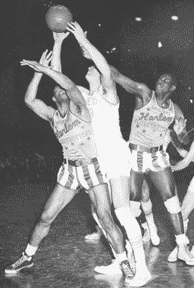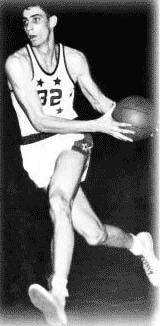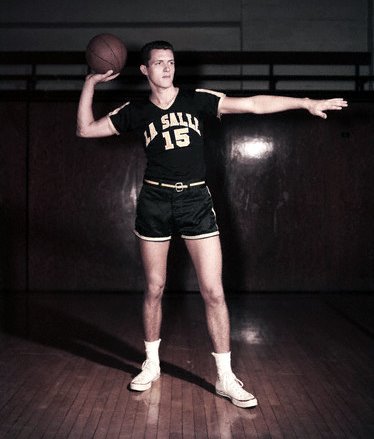CONTENTS
Globetrotters-Lakers Series
Bevo Francis of Rio Grande
Memories of Loyola Field House
Basketball
Snapshots Index
Basketball
Magazine
Golden Rankings Home
Back to Top
CONTENTS
Globetrotters-Lakers Series
Bevo Francis of Rio Grande
Memories of Loyola Field House
Basketball
Snapshots Index
Basketball
Magazine
Golden Rankings Home
Back to Top
CONTENTS
Globetrotters-Lakers Series
Bevo Francis of Rio Grande
Memories of Loyola Field House
Basketball
Snapshots Index
Basketball
Magazine
Golden Rankings Home
Back to Top
CONTENTS
Globetrotters-Lakers Series
Bevo Francis of Rio Grande
Memories of Loyola Field House
Basketball
Snapshots Index
Basketball
Magazine
Golden Rankings Home
Back to Top
|
Globetrotters–Lakers
Series
February
19, 1948: Less than a year earlier, Jackie Robinson
had broken the color barrier in major league baseball with the
Dodgers. Now professional basketball would
experience integration – at least temporarily. Abe
Saperstein, founder of the African-American Harlem
Globetrotters in 1927 and still their coach
and manager, signed an agreement with Max Winter,
general manager of the all-white Minneapolis
Lakers, to play an exhibition game at Chicago Stadium.
The game would be a prelim to the regularly scheduled game between
the Chicago
Stags and New
York Knicks
of the BAA (Basketball Association of America).
The
Globetrotters had
never played in a league. Instead, they toured the nation and the
world playing local teams and demonstrating the showmanship and
trickery that made them fan favorites. Arch Ward,
respected Chicago sportswriter (who had conceived the idea for both
the baseball all-star game and the college-pro football all star
game), wrote that "the Trotters are still the best team in the world." Going into the game
with the Lakers, Saperstein's
club had a 103-game winning streak, although very few of the victories
were over other pro teams.
The
Lakers were the reincarnation
of the Detroit Gems of the National Basketball
League. Upon moving to Minneapolis, the franchise used the first
pick in the 1947 draft to select 6'10" George Mikan,
who had dominated the Professional Basketball League of America
for the Chicago Gears until that league folded.
With Big George in the pivot, the Lakers
quickly established themselves as the best team in the NBL. It is
interesting that the Globetrotters-Lakers
game was considered such a draw that the Chicago
team of the rival BAA agreed to the doubleheader in their building.
A Chicago Stadium record crowd of 17,823 turned out for the doubleheader.
They were not disappointed by the first game, which is what most
came to see.
|
 |
Minneapolis
held a significant height advantage, with several players taller than
the Trotters' 6'3"
C "Goose"
Tatum. Harlem
held a quickness edge, especially in the person of their point guard Marques
Haynes, universally acknowledged as the world's greatest
ball handler. Early on, Tatum was no match for Mikan
as the Lakers jumped to
a 9-2 lead on their way to a 32-23 halftime advantage. Mikan
had scored 18 while holding Tatum scoreless.
The
Trotters adjusted their
defense in the second half. F "Babe" Pressley
started double-teaming Mikan every time he got the ball.
Playing more physically, Harlem
held George to only six points in the second half, fouling
him hard when he got the ball to the point where he drew a technical foul
for pushing the defender who had just fouled him. Mikan
played into the Trotters'
hands by making only 4 of 11 FTs. More missed Laker
shots meant more rebounds to start Trotter
fast breaks. The third quarter ended 42-42.
The
fourth quarter was nip-and-tuck. Tatum and Pressley
both fouled out late in the quarter. The Trotters
tied the game again 59-59 with 1:30 left and then got the ball back. Haynes
dribbled down the clock (no 24-second clock at the time) until, with seconds
remaining, he flipped the ball out to Ermer Robinson
who hit a long set shot as the buzzer sounded. Had he gotten it off in
time? Referee Bill Downes ruled it good. The Globetrotters
had defeated the mighty Lakers
61-59.
The
Lakers easily won the NBL
title and what was billed the World's
Professional Basketball Tournament (in its final year). For the 1948-9
season, the Lakers and three
other NBL teams defected to the BAA, the forerunner of today's NBA.
The
Lakers and Globetrotters
eventually met seven more times, the last in 1958. After losing the first
two, Minneapolis won the
next six. By 1958, the top African-American players were in the NBA, and
the Trotters played entertainment
basketball against patsy teams that toured with them rather than a serious
competitive game.
|
Bevo
Francis of Rio Grande
Like a comet that roars across the sky before burning out, Bevo
Francis needed only two seasons to become a basketball
legend. The 6'9" sharpshooter still holds the NCAA record for
most points in a game (113). His 46.5 average in 1953-4 remains
the Division II high. And these marks were set long before the 3-point
shot.
Born
in 1932 in Hammondsville OH 55 miles west of Pittsburgh, Clarence
Francis was nicknamed "Bevo"
like his father, who liked that brand of beer. Young Bevo
missed two years in grade school because of illness. When he regained
his strength, he shot hoops eight hours at a time. By high school,
he was a "beanpole with a deadly jump shot." He was ruled
ineligible for his first two years because of suspicion (without
proof) that he had been illegally recruited by Coach Newt
Oliver of Wellsville High. When he finally got on the court,
Bevo averaged 30.6 ppg his junior year on a 23-2
team. However, because he had turned 20, Bevo sat
out his senior year.
Nevertheless,
64 colleges offered him a scholarship but he chose tiny Rio
(Rye-o) Grande College
in SE Ohio because its new coach was Oliver. Newt
had led the nation in scoring in 1947-8 while playing for Rio
Grande. The NAIA school had only 92 students, 38
of them male. The gym had no showers or bleachers, a tile floor,
and a leaky roof. Folding chairs were set up to accomodate fans.
Already married with an infant son, Bevo received
a full scholarship and housing.
In
1952-3, Francis led Rio
Grande to a 39-0 season. This win total still ranks
as the most by a college team. Two victims were Dayton
and Cincinnati. However,
27 opponents were teams that did not represent degree-granting institutions
(junior colleges and military bases). Bevo averaged
50.1 ppg, including 116 points on January 19, 1953,
in a 150-85 victory over Ashland (KY)
JC. However, the NCAA refused to recognize his feat
because the competition was a two-year school. (The NAIA does acknowledge
all his games.)
|

Bevo Francis |
For
1953-4, Oliver capitalized on Bevo's
fame by scheduling Creighton,
NC State, Providence,
Villanova, Wake
Forest, and other big-name teams – all on the road.
(Francis still insists that Ohio
State ducked him.) The first test came on December 3,
1953, before 13,000 in Madison Square Garden. Adelphi
ended the Redmen's 40-game
winning streak 83-76. Bevo scored 32 but only four in
the second half. New York writers shouted "Over-rated!"
However,
the next night in Philadelphia, Villanova
needed OT to win 93-92 as Francis drained 39 to recapture
the fickle media. Rio Grande
then beat Providence in
Boston Garden behind Bevo's 41 and Miami
in Florida – he hit 48. In a Christmas tournament in Raleigh, Oliver's
boys lost by 15 to host NC State
but beat Wake Forest by
two. Bevo tallied 34 and 32.
On
February 2, 1954, Francis regained the record the NCAA
had refused the year before. Playing Hillsdale
College of Michigan in a high school gym in Jackson OH,
Bevo made 38 baskets in 70 attempts and 37 of 45 FT for
113 points. Rio Grande
won, 134-91. Hillsdale double
and triple teamed him but he shot on almost every possession. The previous
record of 87 points was set by another Rio
Grande marksman, Jack Duncan, in 1941.
Villanova's Paul
Arizin had 85.
The
Redmen defeated Arizona
State and Creighton
to finish 21-7 and rank in the top 20. Bevo averaged
46.5 for the 27 games against four-year schools. However, his college
career ended abruptly when the school suspended him for skipping classes
and missing exams.
The
NBA did not offer spectacular salaries in 1954. So Bevo
signed for $12,000 with the Boston Whirlwinds, one of
the white teams that traveled with the Harlem
Globetrotters."We'd play two quarters and then be
the clowns," said Francis, who lasted two years
with the Whirlwinds.
In
1956, the Philadelphia Warriors
drafted him in the third round but Bevo turned down their
offer. He barnstormed some more and played in the Eastern League. In the
early 1960s he took a job in an Ohio steel mill, where he worked until
retirement.
|
Memories
of Loyola Field
House

Tom Gola

San Francisco Dons 1956 NCAA Champions

Bob Pettit
|
An
online visit to the La Salle University Basketball Media Guide for 2006-7 gives the date for a game the Explorers played in New Orleans: Sunday night, December 5, 1954. The occasion (not
mentioned in the Guide) was the dedication of the Loyola
Field House on Freret Street uptown in the Crescent City. La Salle, a Christian Brothers
school in Philadelphia, was coming off an NCAA championship in the spring
of 1954 (and an NIT crown in 1952 when the NIT had as much prestige as
the NCAA). They easily defeated the host Wolfpack 85-71. The Explorers' All-American
player was 6'6" Tom
Gola, who could play every position on the court. He started
his pro career with the Philadelphia 76ers when the NBA allowed territorial picks. He played with the Knicks from 1962-66. He coached at his alma mater and was inducted into the Basketball
Hall of Fame in 1974. The school's arena is named for him.
Returning
to the game in New Orleans, a 13-year-old boy attended with his father.
They arrived early and sat midway up the low-sloping seats in the gym,
which was touted as employing the same "theater-seating" design
as arenas at Minnesota, Vanderbilt, and other prestigious
universities. The court was raised so that the fans in the first few rows
looked up at the action. The rows of seats actually angled down from the court until they started to rise. The result was that, even in
row 25, you were already a long way from the court. The team benches were
at the ends of the court. The boy was taking in the scene when he looked
to his right and saw an African-American couple come in and sit next to
him! This was a first. Segregation ruled 1954 Louisiana. However, the
Jesuits who ran Loyola defied
state law by having integrated seating in their new Field House. The boy's
father, sitting to his left, said nothing and certainly didn't grab his
son and move to another location or demand his money back. The boy said
nothing to the couple, and they said nothing to him. No comments were
made by spectators in the area that he remembers.
The
following year, the boy and his father watched in awe as the new defending
NCAA champions, the San Francisco Dons (a Jesuit school), led by 6'10" Bill Russell, played Loyola. The game added integration
on the court to integration in the stands – multiple violations
of Louisiana law. The boy remembers counting the number of steps Russell took to get from one end of the court to the other: only 10. Never had
anyone seen a player so tall who was so quick off his feet. He blocked Wolfpack shots clear into
the audience. The score at halftime was 45-16 as the home team was no
match for the visitors.
Also
in the mid-50s, the St. Louis Hawks,
with LSU's great Bob
Pettit, played the Fort Wayne Pistons in a regular season NBA game at the Field House. The boy remembers passing Bob as he walked to the locker room after the game.
In
the 1960s the boy, now grown, watched many games of the New
Orleans Buccaneers of the ABA at Loyola Field House (1967-1969). Larry Brown and Doug Moe, more famous
later as coaches, played for the Bucs.
The ABA featured the red-white-blue ball.
Another
memorable game at the Field House featured Pistol Pete Maravich.
December 2, 1968: LSU won
easily 109-82. The last few minutes Pete entertained
the packed house with Globetrotter-like antics, such as inbounding the
ball at midcourt by throwing it off the backboard, stepping in and taking
the ball on a big bounce, then swishing a long set shot. Pete later played for the New Orleans Jazz at the Field House (with netting strung across the sides of the court
to keep players from careening into the crowd) before the Superdome opened.
As
you've probably guessed, the boy was the writer, and these are his fond
memories of great players and ground-breaking events at Loyola Field House.
It was demolished in 1986, many years after Loyola had ceased playing Division I basketball in the mid-70s.
|
|
|